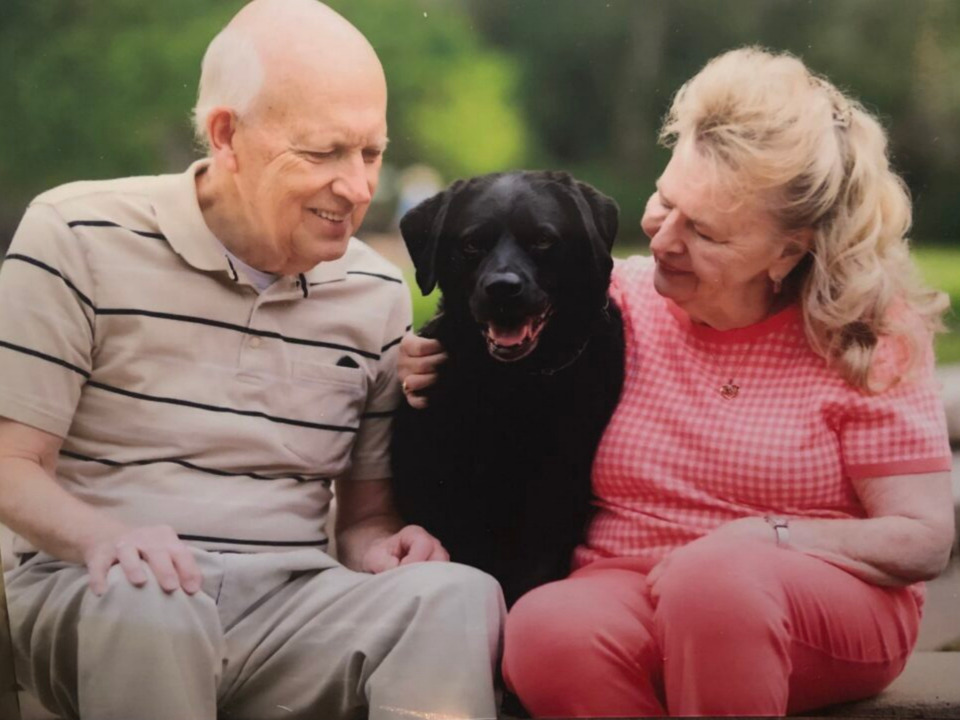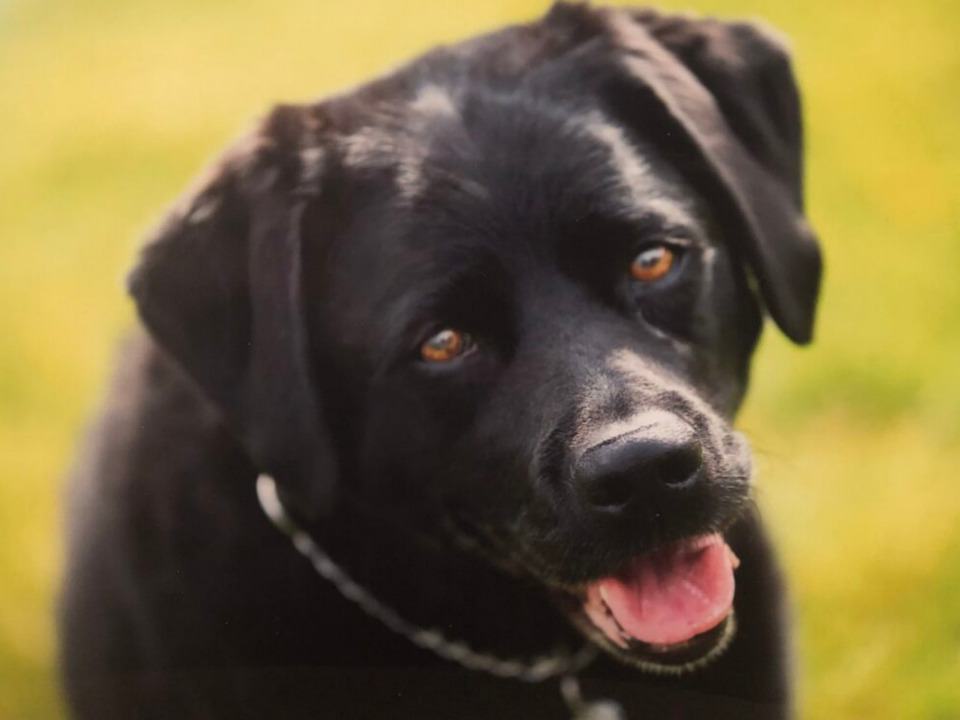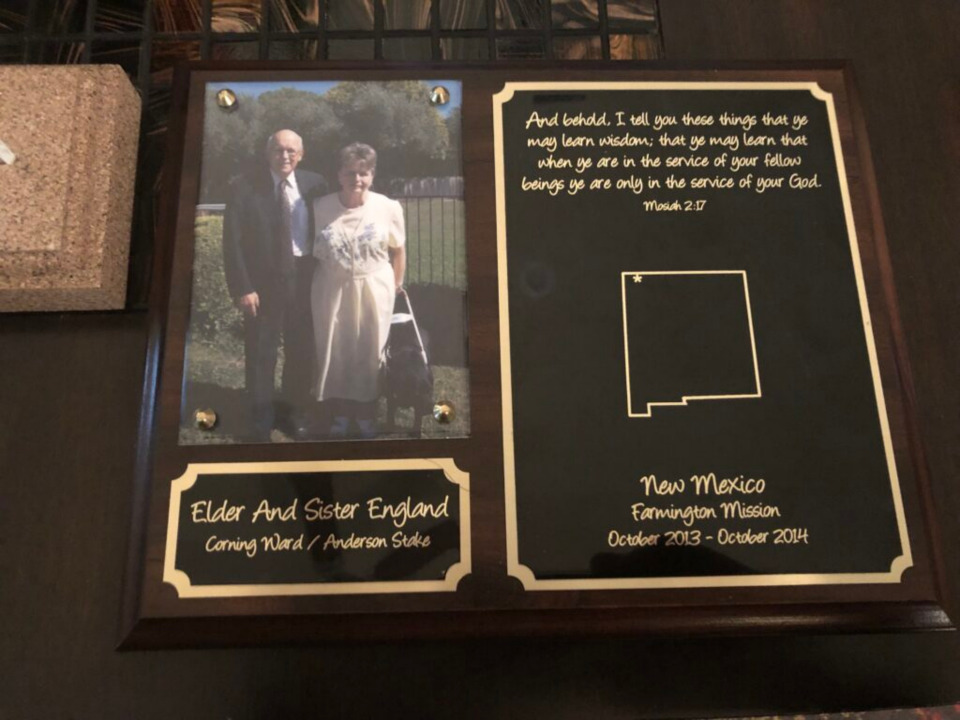
Missionary challenges
West Jordan, Utah, residents John and Sandy England with Sandy’s guide dog for the blind, Jet, in the center. Photo courtesy of England family, courtesy of Church News.All rights reserved.This story appears here courtesy of TheChurchNews.com. It is not for use by other media.
By Mary Richards, Church News
When John and Sandy England started to get promptings about serving a full-time mission, they hesitated — Sandy is blind, and they worried about the challenges. But the Utah couple, currently living in the West Jordan Utah Bingham Creek Stake, knew they had to put their trust in the Lord.
The couple was retired, and had lived at home while serving in the Salt Lake Inner City Service Mission from late 2006 to early 2008. But they could not shake the idea of leaving home for a new mission.
The Englands had been thinking about it for a year before the bishop called them in and talked to them more about it. When they went to their winter home in northern California, the first Sunday there, the message was about serving a mission. So the Englands continued to work toward their goal.
Getting the approvals to bring Sandy’s trained guide dog for the blind to go with them took time. They had issues with their house to work through and concerns about family members and other obligations.
John England spoke about that time: “We found, when you start thinking of serving a mission, all these obstacles come up. What you have to do is persevere and realize the Lord intervenes when He needs to intervene.”
Finally they were called to the New Mexico Farmington Mission. One Sunday before leaving, Sandy England bore a testimony in sacrament meeting about their upcoming mission and some of her feelings. She said Elder David S. Baxter, General Authority Seventy, also happened to be in the meeting that day.
“In my testimony, I mentioned how fearful I was, and I didn’t know what I could offer. But it is a calling and I am going to go,” remembered Sandy. “Then Elder Baxter came up afterward and took both my hands and said, ‘Sister, someone is waiting for you.’”
The Englands got to their mission in October 2013, and attended the Tohlakai Branch in the Gallup New Mexico Stake. “When we got to Tohlakai, the first day we got there and went to church, the person that was waiting for me was there. He was blind. That’s not a coincidence,” said Sandy.
That young man became one of their dear friends, and they were able to see him go through the temple. They stay in contact with him to this day.
“Being blind and feeling scared and feeling very inept; as you go there, it doesn’t go away. But you learn that if you trust in the Lord, He will strengthen you,” said Sandy.
Sandy said she soon realized that other missionary couples also had physical limitations and worries about what was happening back home and other concerns. But they knew they were supposed to be serving at that time.
“You become a family with these people,” she said. “You lift one another up, and you strengthen each other. The first two or three months, you feel like you want to go home. But something just keeps at you to keep going and keep going.”
Serving in Many Roles
The New Mexico Farmington Mission includes the Navajo Nation in the Four Corners area, encompassing parts of New Mexico, Arizona, Colorado and Utah. And Sandy’s guide dog, Jet, soon became a favorite with people they met in the area.
“It opened so many doors, so many doors we couldn’t have opened. Because they love dogs,” she said. “They love all animals, but especially dogs.” Jet even wore an unofficial name tag with the title, “Sister Jet.”

missionary challenges
Jet, a trained guide dog for the blind, accompanied John and Sandy England on their full-time mission from October 2013 through February 2015. Photo courtesy of the England family, courtesy of Church News.All rights reserved.The Englands went to visit a young man they knew in the hospital, and the first thing he said was, “Hi, Jet” instead of “Hi, Elder and Sister England,” John said with a laugh. When they went to a basketball game of a young woman in the branch, she also greeted the guide dog first.
They visited people all over the area, driving long miles to get there. They worked to reactivate members and volunteered at a nearby senior center. And the couple found themselves serving in many different capacities: “We taught the financial class, temple prep class, seminary, Sunday school, I was second counselor in the Relief Society,” said Sandy.
John said, “You don’t know until you get there and start serving what your role is going to be. You have to find out.”
As they taught seminary, the Englands tried new things to help the shiest students to engage in discussions and answer questions, encouraging them as they prompted them to learn more.
Sandy loved watching them grow: “We learned as much about them and the gospel as they were learning from us. It was a give and take.”
And Sandy grew from those early, worried feelings she had from before the mission, to a place of confidence that she was exactly where she needed to be.
“Every time I talked, I said all of us are Heavenly Father’s children. And there is no color difference. There is no race difference. I said, ‘I can’t see you.’ I always joked, ‘I can’t see you, so as far as I’m concerned, I’m just like you.’”
Blessings From Missionary Service
There came a point in their missionary service that Sandy had to return to Utah for an eye surgery. She had some health struggles when they returned to New Mexico, but the Englands asked for an extension so they could keep serving until February 2015.
“You just do it,” said Sandy. “It’s remarkable how you are blessed on your mission. People think we are joking, but I am not. You are blessed by going on a mission.”
Sandy was accepted into a program while on the mission to receive a new implant device to hopefully help her see better (she has retinitis pigmentosa). And she said her oldest daughter told her the rest of the family was being blessed as well by the Englands’ missionary service.
The Englands spoke about learning patience and forgiveness while on their full-time mission. They hope they can serve again on a service mission out of their home, because they know the power of the gospel and have a testimony of missionary work to bless lives.
John was baptized while a young man in graduate school in Missouri; decades later in Texas, he met again the missionary who had baptized him. He said they had a wonderful reunion, full of gratitude that they were both still on the covenant path.
As the Englands talked in their West Jordan, Utah, home, they pointed out two quilts on the couches in their living room, one with a butterfly pattern. The quilts were made by people they had met and grown to love on their mission, including those at the senior center, and those in their branch.
Also around their home are pictures of Jet. Sandy’s faithful guide dog passed away three months ago after serving with them so faithfully on their mission, and helping Sandy every day for almost 12 years.
John said, “It was a sad day for all of us who knew her and loved her but she will always be known as a wonderful friend who did her job well.”

Missionary challenges
A missionary plaque made for John and Sandy England is on display in the Englands’ West Jordan, Utah, home on April 22, 2022. Photo courtesy of England family, courtesy of Church News. All rights reserved.As the interview drew to a close, they pointed again to the plaque in their home with their official missionary picture and the scripture they chose — Mosiah 2:17, which reads:
“And behold, I tell you these things that ye may learn wisdom; that ye may learn that when ye are in the service of your fellow beings ye are only in the service of your God.”
Copyright 2022 Deseret News Publishing Company.